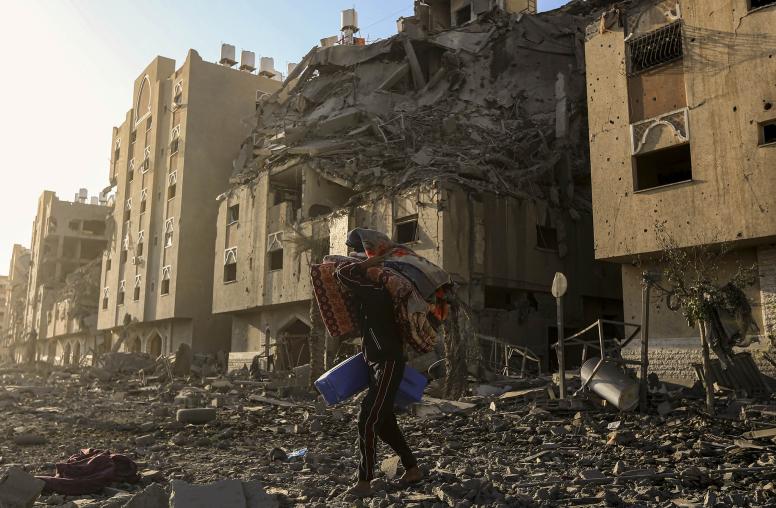What’s Next After Hamas’ Attack on Israel?
With the cessation of hostilities a distant prospect, the threat of spillover into a broader regional war is high.
A week after Hamas’ heinous attack in southern Israel, the grim reality of a protracted war has set in. As of this writing, 1,300 Israelis, mostly civilians, have been killed and Israeli officials believe as many as 150 hostages have been taken by Hamas. U.S. officials have said that 27 U.S. citizens were also killed. As Israel intensifies its operations in the Gaza Strip, 2,000 Palestinians have been killed. There are thousands of wounded on both sides. With Israel calling up 360,000 reservists, a cessation of hostilities seems a distant prospect.

Amid this death and destruction, there are concerns that the conflict could spill over into a broader regional conflagration, as Israel has already been hit several times by rocket fire from southern Lebanon and Syria and retaliated. For its part, the United States is sending Israel $2 billion in military aid — including ammunition, interceptors and other defense technology — and deployed the USS Gerald R. Ford strike group to the region to support America’s closest Middle East ally.
Lucy Kurtzer-Ellenbogen, who directs the Institute’s work on the Israeli-Palestinian conflict, reflects on the impact of the last week’s events and discusses the possibility of a larger regional conflagration.
A week after Hamas’ terrorist attack how do you, as someone who has worked on this conflict for decades, see the events of the last week?
On a human level, it’s absolutely gut-wrenching and devastating. We are unfortunately at the beginning of an inevitably protracted war that has already claimed the lives of countless innocent Israelis and Palestinians, with more heavy losses to come.
On the geopolitical front, this is an absolute game-changer. Existing regional relations at the state-to-state level will be sure to fray, progress toward broader Arab-Israeli normalization will be stalled, and we cannot dismiss the prospect that the conflict could now metastasize throughout and beyond the immediate region, resulting in a multi-front war.
One thing is clear, the Middle East has predictably but explosively forced its way back on the agenda. Any notion that the region can be relegated to a secondary priority for U.S. peace and security interests — or that the Israeli-Palestinian conflict can be “managed” or bypassed rather than accounted for in the pursuit of regional stability — has been dispelled.
How do you see events moving forward in the near-term, and what are the primary concerns?
After an attack of this magnitude, there is little doubt that Israel will respond forcefully. The Israeli government is seeking to inflict as much damage as possible on Hamas and its infrastructure, with Netanyahu having called for “mighty vengeance.” While this goal is impacted by Israeli hostages in Gaza, not to mention a likely reluctance to reoccupy Gaza, a siege of the enclave is already underway. In advance of heightened operations, Israel has warned over 1 million residents of the northern Gaza strip to evacuate southwards over the next 24 hours.
Likewise, Hamas is unlikely to turn corner and release the hostages it has taken or de-escalate, even as Gaza suffers heavy losses of civilian lives. Hamas has been playing a long game. They will have counted on and anticipated a strong Israeli reaction. Not only does this mean they will be willing to absorb what will surely be a significant Israeli response, but it may also mean they still have “tricks” up their sleeves, whether that’s infiltrators still unaccounted for and able to carry out attacks within Israel or activating cells in the West Bank.
Indeed, the fear of destabilizing violence spreading in a repeat of May 2021, through mixed cities, East Jerusalem and beyond into the West Bank, cannot be ruled out. Long discredited with his own people, Palestinian Authority (PA) President Mahmoud Abbas will be further weakened, compromising any ability to keep a lid on violence flaring from extremist Palestinian groups in the West Bank. Escalating violence by extremist Israeli settler groups is also a risk.
The threat of spillover into a broader regional war is also high. Hamas’ call for a “day of rage” was already an explicit rallying cry, and Friday witnessed demonstrations across the region in support of the Palestinian cause. For Israel and the Palestinians’ immediate neighbors — Egypt and Jordan — the fear of displacement and destabilization crossing their borders is paramount. For regional states further afield, the concern is impact on their domestic stability as their populations react to the unfolding crisis.
But all eyes remain on Hezbollah in Lebanon and concern over the opening of a second front. On October 8, Hezbollah targeted an Israeli military post in the Shebaa Farms area with missiles, and on October 9, the Israeli military killed two infiltrators from Lebanon, an attempted operation for which the Palestinian Islamic Jihad claimed responsibility. There have been subsequent skirmishes. Just yesterday, Hezbollah deputy leader Naim Qassem boasted the group would not respond to calls for the militant group to stay out of the conflict, instead claiming the group was “fully ready” to engage in the fight.
While U.S. Secretary of State Antony Blinken has said that the United States and the Israeli military have “not yet seen evidence” of direct Iranian involvement in the Hamas attack, beyond its longstanding material support for the group, and Iran has denied a direct hand, Tehran’s role will continue to get close scrutiny. In this light, U.S. efforts to fortify military support for Israel by deploying an aircraft carrier and strike group are intended as a clear effort at deterrence to those who may seek to exploit and add to the violence.



